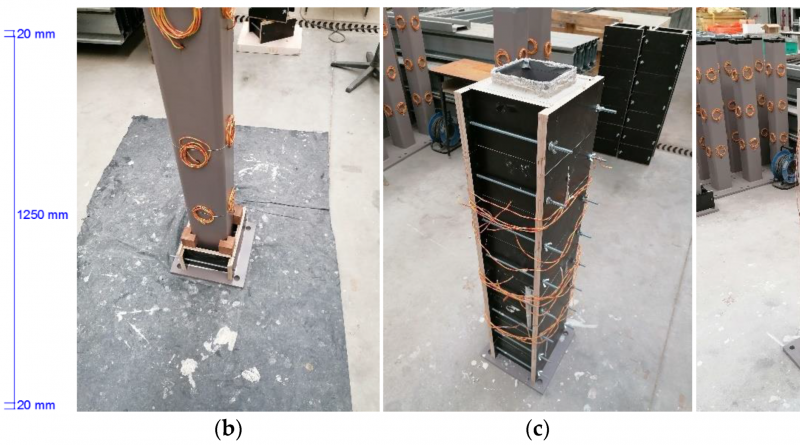2022 Original research published articles
Our latest original research articles in Journal of Applied Sciences (MDPI) and in Journal of Building Engineering are accessible freely using below links:
1- Development of Passive Fire Protection Mortars
Abstract: During a fire event, the stability of steel structures may be compromised, and structural collapse may occur due to the loss of their mechanical resistance as the temperature increases. One of the solutions to reduce this problem is the protection with a coating using enhanced fire-resistant mortars. This paper reports a detailed experimental work aiming to develop gypsum and cement-based mortars for passive fire protection and evaluate their composition’s effect in the final thermal performance. Two types of specimens were tested: (i) small specimens composed of a mortar coating (10 mm thick) and one steel plate and (ii) square section short tubular steel columns with 20 mm of coating. The evaluation of the thermal protection was carried out by (a) measuring the thermal gradient between the exposed surface of the protected steel plate under high temperatures and the mortar-steel interface and (b) assessing the fire resistance of the short steel columns. It was concluded that the compositions with gypsum binder present better thermal insulation than the cementitious compositions. Additionally, the introduction of nano- and microparticles of silica still slightly improved the thermal insulation of the tested compositions.
Link: https://www.mdpi.com/2076-3417/12/4/2093
2- Numerical analysis and structural fire design of protected SHS steel columns with thermally enhanced gypsum-based mortars
Abstract: Fire protection materials should restrict the temperature increase in steel members to prevent premature steel damage and structural failure in case of fire. The design of fire protection materials must be then precise, efficient, and optimized to make steel structures more competitive in the construction sector, thus reducing the impact of one of the worst disadvantages of steel structures. Therefore, this paper presents a numerical investigation into the performance of gypsum-based mortars enhanced with silica micro and nanoparticles as passive fire protection materials to protect the steel columns against fire. Square hollow section (SHS) steel columns were considered for this investigation. Firstly, finite element models were developed and confronted with observations from experimental tests previously carried out by the authors. Secondly, a parametric study was undertaken to study the role of several parameters on the structural fire performance of such columns when exposed to the ISO 834 standard fire curve, including the fire protection thickness and type (composition), column slenderness and load level. Then numerical and analytical results from current design rules in Eurocodes were compared. And finally, changes to the steel temperature prediction method in current design standards were proposed based on the findings of this study. It was observed that the design predictions excessively underestimated the actual fire resistance of the protected SHS steel tubular columns, especially when fire protection mortars with silica micro and nanoparticles were used. The thermal properties of fire protection mortars as a function of temperature must be considered in the structural steel temperature prediction when subjected to fire conditions. It is then strongly recommended that a new revision should be done in the next generation of Eurocodes on this topic based on the proposed modifications or the presented findings.
Link (free access expires on 08 July 2022): https://authors.elsevier.com/c/1f5tn8MyS92iYS

